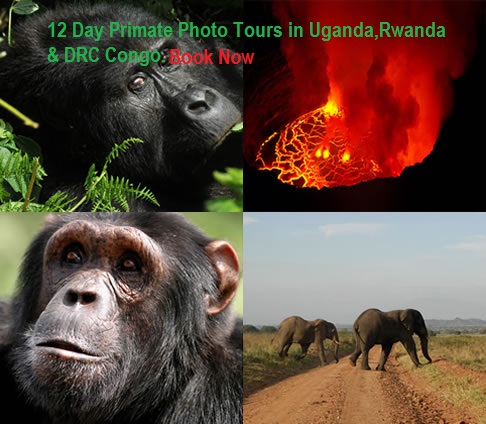Gorillas are often not the easiest subjects to photograph but most certainly one of the most rewarding is when you get it right.
What to avoid when photographing Gorillas
Try your best to avoid subjects that are positioned in bright sunlight, sun rays on their fur blows out completely. It is almost impossible to correctly expose this dark animals and its bright green surrounds in the same frame.
Should you have no option but to shoot in bright sunlight, try for close-up images instead, avoiding as much of the green blown out vegetation.
What to look out for when photographing Gorillas
Weather conditions play a vital role when photographing Gorillas in Rwanda,Uganda and DR Congo.
Soft overcast conditions are the best. Do not be deterred by rainy conditions as these do expose a very different side of Gorilla behavior.
Make sure you are well prepared though with a default camera setting that allows you an adequate shutter speed in these darkened conditions as well as protection for your gear.
What Equipment to bring for Photographic trips
Although with some though and eye for composition you can take reasonable photos with a ‘point and shoot’ camera, you need an SLR camera with one or more lenses if you are all serious about photography.
The most important component in a digital SLR is the sensor. There are two types of senor: DX and FX. The FX is a full size senor identical to the old film size (36mm).
The DX senor is half size and produces less quality. Your choice of lenses will be determined whether you have a DX or FX sensor in your camera as the DX sensor introduces a 0.5x multiplication to the focal length.
So a 300mm lens becomes in effect a 450mm lens. FX (full frame) sensors are the future, so I will refer to focal lengths appropriate to the FX sensor.
Always buy the best lens you can afford. Fixed fast lenses are ideal, but very costly. Zoom lenses make it easier to change composition without changing lenses the whole time. If you carry only one lens a 24-70mm or similar zoom should be ideal.
For second lens, a lightweight 80-200mm 0r 70-300mm or similar will be excellent for candid shots and varying your composition. Wildlife photography will be very frustrating if you don’t have at least a 300mm lens.
For a small loss of quality, teleconverters are a cheap and compact way to increase magnification: a 300mm lens with a 1.4x converter becomes 420mm, and with a 2x it becomes 600mm. NB: 1.4x and 2x teleconverters reduce the speed of your lens by 1.4 and 2 stops respectively.
The resolution of digital cameras is improving the whole time. For ordinary prints a 6- megapixel camera is fine. For better results and the possibility to enlarge images and for profession reproduction, higher resolution is available up to 21 megapixels.
It is important to have enough memory space when photographing on your holiday. The number of pictures you can fit on a card depends on the quality you choose.
You should calculate how many pictures you can fit on a card and either take enough cards or take a storage drive onto which you can download the card’s content.
You can obviously take a laptop which gives the advantage that you can see your pictures properly at the end of each day and edit and delete rejects.
If you don’t want the extra bulk and weight you can buy a storage device which can read memory cards. These drives come in different capacities.
Keep in mind that digital camera batteries, computers and other storage devices need charging. Make sure you have all the chargers, cables, converters with you. Most hotels/ lodges have charging points, but it will be best to inquire about this in advance.
How to keep your Equipment from Dust & Heat
Dust and heat are often a problem. Keep your equipment in a sealed bag and avoid excessive exposure to the sun. Digital cameras are prone to collecting dust particles on the sensor which results in spots on the image.
The dirt mostly enters the camera when changing lenses, so be careful when doing this. To some extent photos can be cleaned up afterwards in photo shop, but this is time- consuming.
You can have your camera sensor professionally cleaned, or you can do this yourself with special brushes and swabs made for the purpose, but note that touching the sensor might cause damage and should be done with the greatest care.
At what time is it best to shoot good photos?
The most striking outdoor photographs are often taken during the hour or two of golden light; after dawn and before sunset.
Shooting in low light may enforce the use of very low shutter speeds, in which case a tripod might be required to avoid camera shake.
With careful handing, side lighting and back lighting can produce stunning effects, especially in soft light and at sunrise or sunset. Generally, however, it is best to shoot with the sun behind you.
When photographing animals or people in the harsh midday sun, images taken in light but even shade are likely to be more effective than those in direct sunlight or plenty shade, since the latter conditions create too much contrast.
Take a note that
In some countries, it is unacceptable to photograph local people with out permission and many people will refuse to pose or will as for a donation. In such circumstances, don’t try to sneak photographs as you might get yourself into trouble.
Even the willing subject will often pose stiffly when a camera is pointed at them; relax them by making a joke, and take a few shots in quick succession to improve the odds of capturing a natural pose.
